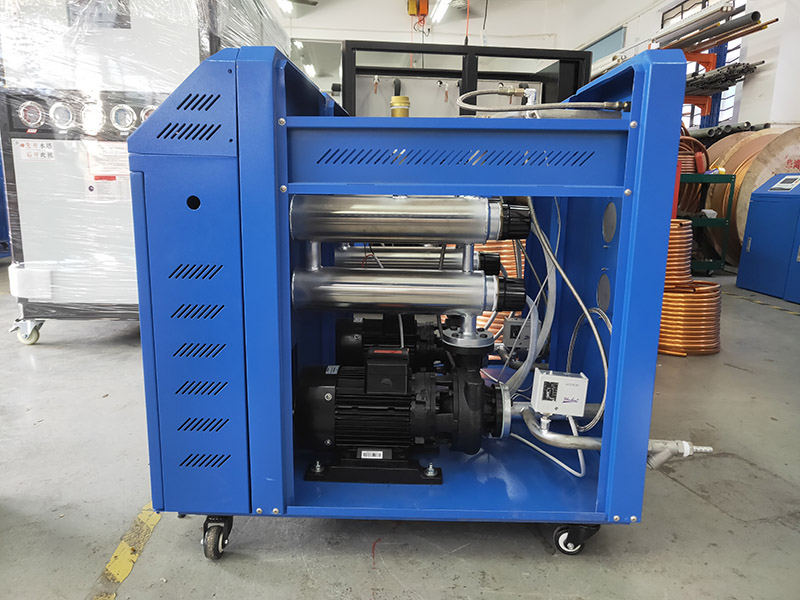In the field of precision processing in modern manufacturing, the precise control of mould temperature is like a meticulous surgical operation, which directly affects the quality of products and the production efficiency. And the mould temperature controller is precisely the key operator in this "temperature control surgery", quietly yet vitally influencing the production processes of numerous industries.

The Core Principle of the Temperature Controller: The Ingenious Integration of Technology and Heat Conduction
The working principle of the mould temperature controller incorporates sophisticated thermal and mechatronics technologies. It uses advanced temperature sensors to monitor the temperature of the mould in real time, just like sensitive nerve endings that accurately capture every slightest temperature change. Once the measured temperature deviates from the preset ideal value, the temperature controller quickly activates the heating or cooling devices. During heating, efficient heating elements such as heating tubes convert electrical energy into heat energy efficiently and uniformly transfer it to the mould through heat transfer media (commonly water, oil, etc.), dispelling the "coldness" of the mould and raising its temperature to a suitable working condition. In the cooling process, the refrigeration compressor or the chilled water circulation system is used to forcibly absorb the excess heat of the mould, just like applying a cool "ice pack" to the hot mould to ensure that the temperature remains stable within the set range. This dynamic and real-time adjustment mechanism guarantees that the mould remains at a constant temperature throughout the entire production cycle, creating a stable "incubator" for product forming.

The Wide Range of Applications across Industries: The "Standard Temperature Control Equipment" in Multiple Areas of Manufacturing
The plastic injection moulding industry is the first to rely heavily on the mould temperature controller. When the plastic melt is injected into the mould cavity, it is extremely sensitive to the mould temperature. Precise temperature control can avoid defects such as sink marks, flash, and deformation in products, making the surfaces of plastic products smooth and their dimensions accurate. Whether it's delicate plastic toys or complex automotive interior plastic parts, they all rely on it to control the temperature.
The same is true in the die-casting field. When the high-temperature liquid metal solidifies and forms in the mould, the temperature controller precisely adjusts the mould temperature, helping the molten metal to cool evenly, reducing defects such as pores and blowholes, improving the compactness and mechanical properties of die-casting parts, and ensuring the high-quality production of aerospace components, precision parts of industrial machinery, and so on.
In the rubber moulding process, the vulcanization reaction of rubber materials is influenced by temperature. The appropriate temperature range is maintained by the temperature controller to ensure that rubber products are fully vulcanized and have appropriate elasticity. From common tyres to various rubber seals, the stability of their quality stems from this. Even in niche yet crucial fields such as composite material forming and food packaging moulds, the mould temperature controller also quietly plays its role, achieving product quality with a constant temperature.
The Outstanding Advantages of the Equipment: Stable and Efficient, a Capable Assistant for Enterprise Production
Stability is a major highlight of the mould temperature controller. It can resist the interference from the complex and changeable environment in the workshop. Fluctuations in grid voltage and the impact of heat dissipation from surrounding equipment are hardly able to affect its precise temperature control ability, ensuring the continuous and stable operation of the production line, reducing the scrap rate, and minimizing losses caused by shutdowns and restarts due to abnormal temperatures, thus saving a lot of costs for enterprises.
The convenience of operation also makes it highly favored. Modern temperature controllers are equipped with intelligent touch screens, making parameter settings and monitoring of the operating status clear at a glance, enabling even novice operators to quickly get the hang of it. The rich alarm prompt functions, such as timely notifications to maintenance personnel when there are abnormalities like temperature exceeding the limit or medium leakage, can help prevent problems before they occur. The compact and reasonable body design occupies a small area and is convenient for flexible layout in the workshop, fitting into various production line layout architectures.
The energy-saving feature is even more in line with the current trend of green manufacturing. Advanced frequency conversion technologies adjust the heating and cooling power intelligently according to the actual temperature requirements, avoiding excessive energy consumption. High-efficiency heat exchangers improve energy utilization. In long-term and large-scale production, the accumulated energy savings from these small efforts can bring considerable economic benefits and contribute to the sustainable development of enterprises.
Although the mould temperature controller is often hidden behind the production line, with its continuous and stable temperature control performance, widely adaptable application capabilities, and continuously advancing technological advantages, it lays a solid temperature foundation for the high-quality and refined development of the manufacturing industry, continuously promotes the quality innovation of industrial products, and has become an indispensable key equipment force in modern manufacturing. In the future, with the iteration of technology, it will surely unlock more temperature control potentials and expand into broader application areas.